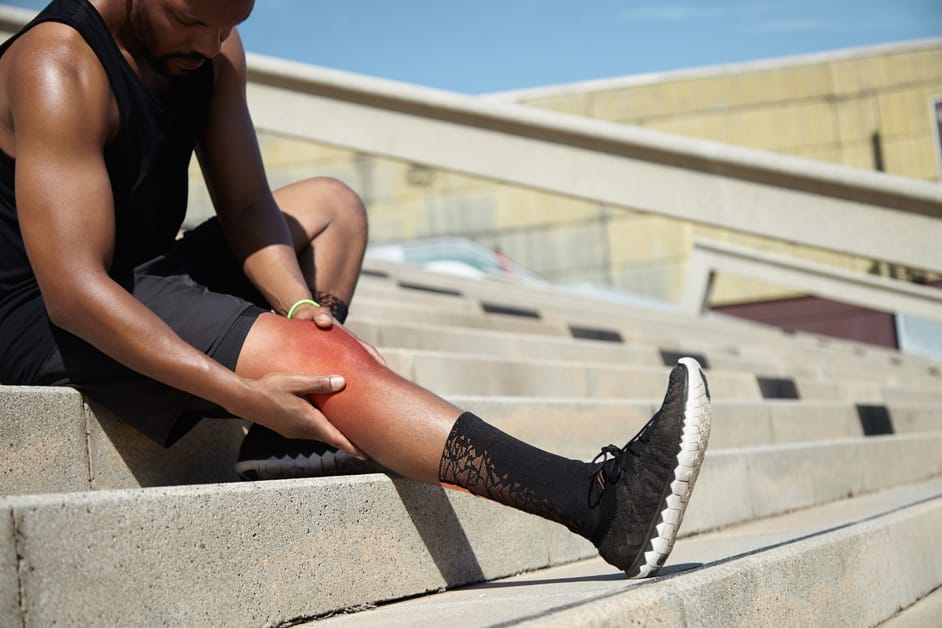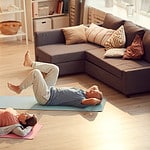Warm Up
Keep joints loose and avoid knee pain during exercise? Warm up muscles and joints first! This warm-up will help your body adjust to the activity. It will activate the muscles and make them more elastic. Plus, it’ll raise the internal temperature, helping your body move and burn energy better.
Let’s look at the best ways to warm up before exercise:
Dynamic stretching
Dynamic stretching is a must-do for any warm-up routine. It readies the body for activity and decreases the chance of getting hurt. Dynamic stretches involve stretching while in motion, not like static stretching. Examples include:
- Lunges
- Jumping jacks
- Knee-to-chest pulls
- Leg swings
- Shoulder rotations
Doing dynamic stretches before exercise helps with joint flexibility, range of motion, blood flow and joint movement. This is especially beneficial for seniors who have less mobility due to age or medical condition. To be safe, do 10-15 reps of each dynamic stretch for 30 seconds. That’s enough for a proper warm-up of joints and muscles before physical activity or exercise.
Foam rolling
Foam rolling is super popular now! It involves a cylinder covered with high-density foam to massage soft tissues. It helps improve flexibility, reduce muscle tension and increase range of motion. It also increases blood flow – great for injury prevention and healing.
When foam rolling, be gentle and consistent when exerting pressure. Start with dynamic stretching: hip flexor and calf stretches, glute activation exercises.
Concentrate on main muscle groups like hamstrings, quads, glutes, calves for 30-90 seconds per area. You can use arms or legs to give an even deeper massage if desired. Remember to breathe deeply for maximum benefits!
Strengthening Exercises
Seniors! To protect your knees when exercising, strengthening exercises are the way to go. These exercises target the muscles around your knee-joint, and help to increase strength and endurance. This article has tips and advice on strengthening exercises that can reduce the risk of knee pain when you exercise. Get ready to increase your stability and support!
Leg lifts
Do leg lifts to improve your leg strength and avoid knee pain. Lie on your back, both legs bent at 90° with feet flat. Keep hands by sides, eyes on the ceiling, and lift one leg until it is perpendicular to the floor. Hold for two seconds and then lower it back. Do this 10 times. Change legs and repeat.
Focus on your core, don’t arch your lower back. Make it harder by using ankle weights, resistance bands, or circles. You can also do hip bridges and presses using both legs.
Squats
Squats are a great way to work the muscles in your legs and lower body. Plus, they help with balance and range of motion. Doing them right can reduce knee pain from activities that involve weight on the joint. Here’s how:
- Stand with feet wider than hip-width apart. Toes should be slightly turned out. Arms to your sides.
- Slowly lower your hips until you reach a 90-degree angle.
- Raise up to a standing position. Do 10 reps for 2-3 sets, increasing reps/sets as you get stronger.
- Keep your spine straight, no arching of the back. Knees should not pass over toes. Push through your heels instead of toes!
Follow these tips for safe, correct squats:
- Even weight distribution from heel to toe
- Engage core
- Exhale on exertion (as you stand up)
- Use a chair for extra stability if needed.
Lunges
Lunges are a great choice for seniors who want to do strengthening exercises. They are easy to add to any routine, and don’t need much equipment or space. Lunges help strengthen the leg muscles and can also improve balance, mobility, and coordination.
- Start by standing with feet together.
- Step forward with one foot into a hip-width stance. Bend both knees until your back knee reaches the ground – do this in a controlled way.
- Push off and return to standing with your weight on your front heel.
Keep your spine straight throughout the exercise. Hunching over can put strain on your lower back. Make sure no pain is present and that you feel comfortable. Try for 10-12 reps on each leg at a comfortable pace.
Stretching
Stretch for knee pain prevention! It’s a great tip for seniors. Stretching can increase flexibility, reduce stiffness and improve range of motion. Also, it keeps muscles healthy and strong, avoiding injuries.
Let’s look into why stretching is so beneficial for seniors:
Hamstring stretches
Hamstring stretches are key for decreasing knee pain when working out. This muscle group helps support your knee, so it’s essential to keep it strong and flexible. Here are some simple hamstring stretches to do each day:
Static Stretch: This involves holding a position for at least 15-30 seconds, with no bouncing or moving. Examples include seated hamstring stretch, standing forward fold and lying back swing. To get the best results, focus on drawing your belly button inwards and keep your spine neutral.
Dynamic Stretches: Dynamic stretching is more active than static stretching. You need to move continuously to get the best results. Examples include
- walking lunges,
- leg swings,
- and toy soldiers marching in place.
When doing dynamic exercises, remember to keep your core tight to protect your spine. Also, engage your glutes (butt muscles) throughout the exercises to protect your legs from injury.
Quadriceps stretches
Quadriceps stretches can help reduce knee pain and improve strength. The quadriceps muscles are located on the front of the thigh. They curve around the kneecap and connect to the shin bones, allowing you to straighten and lift your kneecaps. Doing the right stretches can help seniors increase mobility and lessen knee pain.
When stretching, don’t do it too far or too quickly. Ease into it slowly and hold for a few breaths at each level until you feel comfortable going further. Here are some common quadriceps stretches seniors can do:
- Standing Quad Stretch – Stand with feet together and hands on hips. Lift one leg off the floor and keep the knee pointed down. With a bend in both knees, use one hand to grab the lifted ankle. Steady yourself against a wall if needed. Move gently into a deep quad stretch, feeling tension at the front of the thigh and keep hips facing forward. Hold for 30 seconds, then repeat with the other leg.
- Couch Stretch – Face away from the couch with feet hip width apart. Place the right foot onto the couch, slightly bent, and keep the left foot firmly rooted on the ground. Place hands on the couch, bend from the hip forward until you feel the stretch around the front of the thigh. Hold for 30 seconds, then switch sides.
- Seated Quad Stretch – Sit in an upright chair, ensuring the spine is straight and comfortable. Reach back with one hand and grab the ankle. Slowly pull the foot up towards the buttocks or lower back, keeping legs close together. Take care not to lean back. You should feel a gentle pull at the inner thighs. Set a timer for the desired hold time, then switch sides.
Calf stretches
Calf stretches are key for any workout. They can help loosen up tight calves and nearby structures, reducing injury risk. Plus, they can help manage knee pain. Here are some calf stretches seniors should do regularly:
- Wall Calf Stretch: To warm up calves before exercise, stand facing a wall. Place hands on wall at shoulder height. Place one foot two feet back, heel on floor. Keep front leg bent while pressing back leg straight against wall until you feel a stretch. Hold 30 seconds before switching sides.
- Standing Calf Stretch: This stretch is great for isolating specific areas. Stand with feet together, hands clasped on hips for balance. Step forward with one foot, bending back knee slightly & pushing down through heel until stretch felt in each back leg’s calf muscle. Keep toes facing forward. Hold 15-20 seconds before repeating on both sides several times.
Balance Exercises
Balance exercises are a must for seniors to avoid knee pain when exercising. They assist with muscle strength, stability and coordination. Not only do they help the muscles around the knee joint, but they can also reduce the risk of falls and other accidents.
Let’s discuss the advantages of balance exercises and some tips to get going!
Single-leg balance
Single-leg balance exercises are great for improving knee stability, posture and balance in seniors. Strengthening your lower body muscles can help relieve pain and reduce the chance of knee injury.
To do this exercise, stand comfortably with one foot off the ground. Point your toes forward and extend your arms in front of you or hold them above your head for more stability. Activate your core muscles and keep a slightly curved spine. If needed, use a wall or chair for support.
Hold for 10 seconds, then switch legs. Start with 15 reps per leg to focus on both sides of the body and build muscles. Increase to 25 reps if desired. This exercise also stretches tight calf and hip flexor muscles. It offers an individualized program targeted at lower extremity pain relief and better balance control.
Standing on one leg
Stand straight with feet hip-width apart. Arms outstretched in front. Lift one foot off the ground. Point it back or hang it. Remain there 15-30 seconds. Switch legs and repeat. As you get stronger, increase duration to 45-60 seconds.
Add a twist – close eyes or use an unstable surface. Make small movements with the lifted foot. Circles or tapping it for extra challenge. Simple but effective balance exercise!
Heel-to-toe walking
Heel-to-toe walking is a great way to strengthen and stabilize your lower body. You need coordination, stability, and balance for this exercise. It can help improve balance and build strength in your ankles, hips, and core muscles.
Start off by standing with your feet together. Place one foot directly in front of the other, so that your heel of one foot is touching the toe of the other. Don’t look down; keep your eyes straight ahead.
To make it harder, swing your arms as you walk heel-to-toe. This adds more of a challenge to the stabilizing muscles in your back, and improves coordination. Keep soft knees and a slight bend in both legs as you go forward for 20 yards or so. Swing the opposite arm and leg together for better rhythm and control.
This exercise is great for seniors wanting to do balance exercises, strength training, and stability exercises.
Cool Down
For seniors, cooling down after a workout session is a must to avoid knee pain. It can give you more range of motion and less knee discomfort. Cooling down also helps to reduce the recovery time between sessions, so you can enjoy your workout to the fullest.
Let’s discuss the importance and benefits of cooling down after exercise!
Static stretching
Static stretching is a style of stretching that uses your bodyweight to stretch the muscles. It helps with flexibility, by lengthening the muscles, tendons, and ligaments. Holding each stretch for 30 seconds increases blood flow and reduces soreness, as well as boosting relaxation.
Examples of static stretches are seated toe touches, quadriceps stretches, hip flexor stretches, hamstring stretches, and butterfly stretches. Don’t push too far; straining or injuring yourself is possible. For best results, hold each stretch for at least 30 seconds before moving on.
Include static stretching in your cool down routine after workouts or physical activities – you’ll thank yourself afterwards!
Foam rolling
Foam rolling is an awesome self-massage technique. It can help prevent knee pain and soreness after exercise. This type of massage therapy uses a firm foam roller placed on the ground. Pressure is applied to specific areas. This helps reduce tightness which can lead to pain or injury.
Seniors tend to have stiffer muscles as they age. A foam roller could be beneficial for them.
To use it for knee pain prevention:
- Position your body on the foam roller.
- Move back and forth slowly for 15-30 seconds.
- Spend more time working on muscles around painful joints and those that become tense when you exercise.
- You can also apply slight pressure with your hands. This helps promote relaxation in targeted areas with tightness.
Supplement your foam rolling routine with dynamic stretching exercises. These allow deeper muscles to get stretched out. They also help increase range of motion in joints post exercise or stretching session.
Frequently Asked Questions
Q: What kind of exercises are best for seniors with knee pain?
A: Strengthening exercises that focus on the muscles around the knee joint, such as squats and lunges, are ideal for seniors with knee pain. It is important to use low-impact exercises that do not put too much strain on the joint. Other good exercises include swimming, cycling, and yoga.
Q: What can I do to prevent knee pain during exercise?
A: It is important to warm up and stretch before any exercise. Stretching the muscles around the knee joint can help prevent knee pain. Additionally, it is important to use proper form and technique when exercising to avoid putting too much strain on the knee. Wearing a knee brace and using a foam roller can also help to reduce pain and discomfort.
Q: Are there any tips for seniors with knee pain to help relieve pain?
A: Resting the knee and avoiding activities that put too much strain on the joint can help to reduce pain. Ice can be applied to the knee to help reduce inflammation, and over-the-counter medications such as ibuprofen and acetaminophen can help to relieve pain. Additionally, a physical therapist can provide exercises and stretches that can help to reduce pain and improve mobility.





